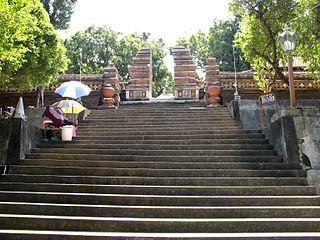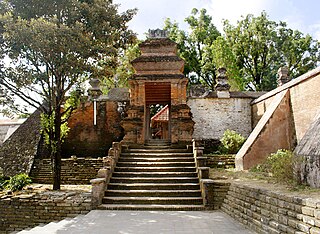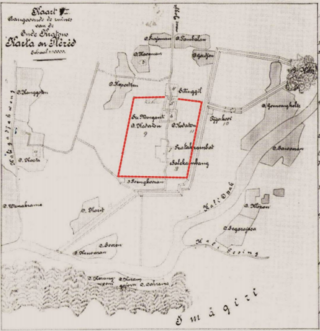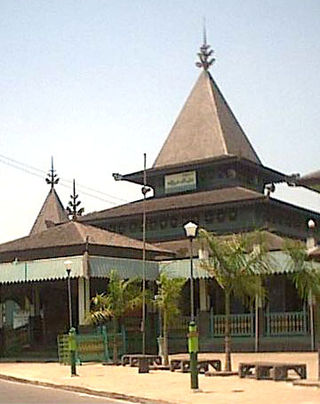
Banten is the westernmost province on the island of Java, Indonesia. Its capital city is Serang and its largest city is Tangerang. The province borders West Java and the Special Capital Region of Jakarta on the east, the Java Sea on the north, the Indian Ocean on the south, and the Sunda Strait on the west and shares a maritime border with Bengkulu and Lampung to the east and Bangka Belitung Islands to the north. The province covers an area of 9,352.77 km2 (3,611.12 sq mi). It had a population of over 11.9 million in the 2020 census, up from about 10.6 million in 2010. The estimated mid-2023 population was 12.308 million. Formerly part of the province of West Java, Banten was split off to become a province on 17 October 2000.

Imogiri is a royal graveyard complex in the Special Region of Yogyakarta, in south-central Java, Indonesia, as well as a subdistrict under the administration of Bantul Regency. Imogiri is a traditional resting place for the royalty of central Java, including many rulers of the Sultanate of Mataram and the current houses of Surakarta and Yogyakarta Sultanate. The name is Imagiri is derived from the Sanskrit Himagiri, which means 'mountain of snow'. The latter is another name for Himalaya.

Javanese sacred places are locations on the Island of Java, Indonesia that have significance from either village level through to national level as sacred, and in most cases deserve visitation—usually within the context of ziarah regardless of the ethnicity or religion of the visitor. The dominant form for many places is a sacred grave, or a place associated with persons considered to have special attributes in the past—like Wali Sanga or Royalty.

Kotagede is a city district (kemantren) and a historic neighborhood in Yogyakarta, Special Region of Yogyakarta, Indonesia. Kotagede contains the remains of the first capital of Mataram Sultanate, established in the 16th century. Some of the remains of the old Kotagede are remains of the palace, the royal cemetery, the royal mosque, and defensive walls and moats. Kotagede is well known internationally for its silver crafting.

A mazār, also transliterated as mazaar, also known as marqad (مَرْقَد) or in the Maghreb as ḍarīḥ (ضَرِيْح), is a mausoleum or shrine in some places of the world, typically that of a saint or notable religious leader. Medieval Arabic texts may also use the words mašhad (مَشْهَد) or maqām to denote the same concept.

Plered was the location of the palace of Amangkurat I of Mataram (1645–1677). Amangkurat moved the capital there from the nearby Karta in 1647. During the Trunajaya rebellion, the capital was occupied and sacked by the rebels, and Amangkurat died during the retreat from the capital. His son and successor Amangkurat II later moved the capital to Kartasura. It was twice occupied by Diponegoro, during the Java War (1825–1830) between his forces and the Dutch. The Dutch assaulted the walled complex in June 1826, which was Diponegoro's first major defeat in the war.

Sultan Suriansyah Mosque is the oldest mosque in South Kalimantan. Built in 1526 during the reign of Sultan Suriansyah, the first Banjar King to convert to Islam. The mosque is located in the village of Kuin Utara, in Banjarmasin.

The Bantenese are an indigenous ethnic group native to Banten in the westernmost part of Java island, Indonesia. The area of Banten province corresponds more or less with the area of the former Banten Sultanate, a Bantenese nation state that preceded Indonesia. In his book "The Sultanate of Banten", Guillot Claude writes on page 35: “These estates, owned by the Bantenese of Chinese descent, were concentrated around the village of Kelapadua.” Most of Bantenese are Sunni Muslim. The Bantenese speak the Sundanese-Banten dialect, a variety of the Sundanese language which does not have a general linguistic register, this language is called Basa Sunda Banten.

Gunung Wukir temple, or Canggal temple, or also known as Shivalinga is a Shivaite Hindu temple dated from the early 8th century, located in Canggal hamlet, Kadiluwih village, Salam subdistrict, Magelang Regency, Central Java, Indonesia. The temple dates to the year 732, making it the first structure attributed to the ancient Mataram kingdom, which ruled Central Java from 732 to around the middle of the tenth century.

Paduraksa, also known as kori is a type of gateway covered with towering roofs that can be found in the island of Java and Bali, Indonesia. This architectural feature is commonly found in buildings from the classical Hindu-Buddhist period of Indonesia. Paduraksa marks the threshold into the most sacred space within a religious compound, a cemetery, or a palace. In Balinese architecture, an elaborately decorated towering paduraksa is often built as the temple's most imposing structure.
Banten Girang is an ancient settlement located in Sempu village, Serang city, Banten province, Indonesia. It is located by the Cibanten River about 10 km south of the port of Banten, on the southern outskirts of Serang town. In that place there is an archaeological site which estimated dated to the era of Sunda Kingdom between 932 and 1030 CE. The term Banten Girang, meaning "Banten-up-the-river" referring to its location.

The Tomb of Ratu Mas Malang is a tomb and cultural site located in near the village of Plered in the Bantul Regency of Indonesia. It is the tomb of Queen Malang, one of the wives of Amangkurat I of Mataram. The tomb was built using white stone, and construction finished in 1668. The tomb has since been damaged by environmental factors.

Giri Kedaton was an Islamic kedatuan located in Gresik, East Java and existed in the 15th to 17th centuries, until Giri was conquered by the Mataram Sultanate in 1636.
The Royal Ambarrukmo Yogyakarta is a hotel located in Sleman Regency, Yogyakarta, Indonesia. The hotel was built at the direction of Indonesian President Sukarno from 1964 until 1966, along with Jakarta's Hotel Indonesia, Pelabuhan Ratu's Hotel Samudera, and Bali's Bali Beach Hotel. The hotel was built on the site of the former Ambarrukmo Palace, a 19th-century royal residence of the Yogyakarta Sultanate, from which the hotel derives its name. The buildings of the former palace still stands and is now housed within the hotel compound.
Banyusumurup Mosque is a historic mosque located within the Banyusumurup Cemetery area, Yogyakarta, Indonesia.

The Makam Keramat Tujuh, also known as Kompleks Makam Keramat Tujuh is a historic funerary and religious complex located in the town of Mulia Kerta in Ketapang, West Kalimantan, Indonesia. The religious complex also served as a burial ground for relatives of the rulers of the Mataram Sultanate, which ruled Java from 1586 to 1749.

The Shrine of Datuk Shaykh al-Azhar is a historic shrine located at Jalan Sudirman street in the area of Pasar Taluk in Kuantan Singingi Regency, Riau, Indonesia. It contains the grave of a Sufi Muslim cleric who introduced Islam to the city of Teluk Kuantan.














